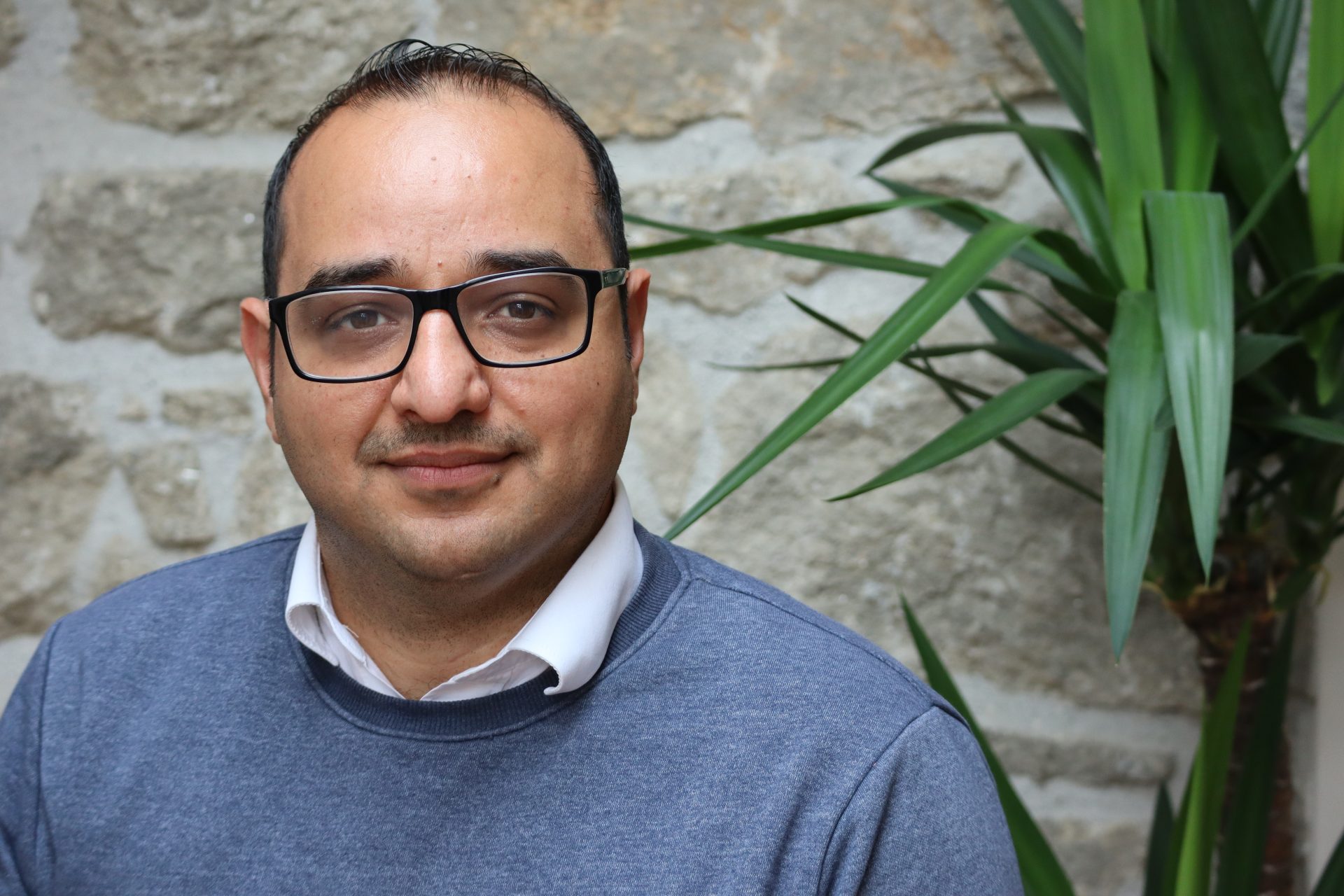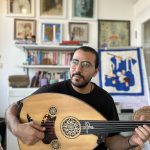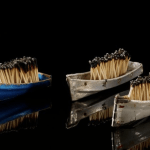Muhammad Achour is a Syrian architect based in Dublin, Ireland. Fascinated by the possibilities of community engagement, he is the founder of Places of ARcture, “a social enterprise to educate for using art and architecture as a tool to engage with local communities”, which aims to form a network of artists, architects and educators through the curation of exhibitions, events, seminars and projects. Recently, the organization collaborated with The London Festival of Architecture (LFA) to curate and display the work of Syrian practitioners at the Victoria & Albert Museum in June 2022.
A Member of the Syrian Engineers Syndicate, Muhammad worked as a teaching assistant at Aleppo University and as a lecturer at Al-Ittihad, a private university in Aleppo. Forced to leave Syria as a result of the conflict in 2015, Muhammad secured permission to join his older brother in Ireland as part of the Syrian Humanitarian Admissions Programme (SHAP) that offered Irish residence to people who are in danger in Syria and have close family members residing in the state. However, it did not provide social welfare or access to the medical care system. Before leaving Syria, Muhammad applied for and was offered a a teaching assistant position at Dublin City University (DCU).

Why architecture? Was it something you always wanted to do, something your parents were involved in?
Why architecture? It’s a funny story.
I was raised in Aleppo in a house close to the university. There, all of the families tell their children, “work hard, study hard, you have to go to medical school”. My uncle was also a doctor, so during secondary and high school, I was pressured to do this, but I worked hard just trying to do my best and to choose the career later.
I had a connection with the old city, with the architecture. I love how Aleppo is built with limestone, all the buildings have this exterior wall clad in white stone, but if you go to Damascus, it is a completely different style of construction.
In 2000, my story with architecture started. As I didn’t get good marks in the high school examinations, I was going to lose my chance to go to the engineering school, but that year, the architecture schools made new entry conditions and invited more people. I was eligible to try for the two exams, and I went to a family friend who was an architect and told her I was applying to architecture school. I showed her my drawings and she said, “you have talent”, which I didn’t know as the education system in Syria did not encourage students to explore their talents. There was no place in the curriculum with a course to prepare students for architecture school. Art class was sometimes swapped for another subject, or the art teacher did not engage the students with arts. So I had the talent, but it wasn’t noticed, and I never knew that I had this gift. So I did the two exams and started, spending five years at the school before I graduated in 2007.

You have done a number of workshops with younger children, such as Play in Architecture. I imagine there is, not necessarily a frustration, but perhaps a way of making up for where you weren’t encouraged as a child to draw, or to think about architecture. I think worldwide there is this notion of “the architect”, as a big word, and it is very hard to diffuse down to both children and to the general public that it is not such an inaccessible thing. I’m sure being a doctor is a much harder profession to obtain.
I feel that people who have missed something in their childhood, or miss out on something in general try to solve this problem.
The Play in Architecture workshop invites kids to enjoy and experiment with architecture. To play. With children you have to make them excited to come and to learn. They begin just connecting the dots, but then they start to draw a house. We can start from an early stage of education and talk about architecture. However, I am not inviting them to an architecture school, I am just inviting them to be creative. To invite these talents and give them the techniques to grow.
In Ireland, we have the Irish Architecture Foundation (IAF) that works with adults and children. I am part of the Architects in Schools programme. I have done some projects with them, but I want to change what people think of when they hear about architecture workshops. They always think about model making. Even the architects who do these workshops start to plan for model making. Model making is a very important and fun activity, but it is not the only way. We can go beyond that. We can start to think through a full design or planning with landscape within these short programmes in workshops.
I’m trying to advocate for a different kind of workshop that engages with architecture education in the early stages, similar to two organizations in the UK that have held similar online events – the Thornton Education Trust (TET), and an office called Matt+Fiona. In Ireland, we have A Playful City.

The naive perspectives of children are incredibly strong when thinking about design and site, in the sense that they think through their feelings. I saw a fascinating drawing once where a child had mapped out their day. They had drawn their house and their family to the size that they feel it – their parents were the same height as the tree whilst they were the size of a flower. I think there is something really nice about that. Rather than tackling a site with this logical representation through a plan and section, the child just drew what they experienced. It demonstrated a very emotional and felt connection to space rather than this clear cut, adult and logical way of approaching it.
Yes, so they are drawing for themselves!
Within these projects, I am developing my own methodology for Imaginary Public spaces. I suggested a green field near the students’ school and asked, ‘what would you like to do with this space?’ I was asking about their passions and what they would do after school. One of them did theatre for anyone to come and do a play. They designed, sketched it and made the plans. There were a lot of creative ideas, for example, one of them told me he wanted a place to play golf. I told him it was a small space, but he said, yes, he wants to make a VR Golf. I learnt from them in the workshop, and it gave me ideas for later.

You have also worked with older students, curating an exhibition at DCU for Syrian architects – The Syria Architect Art Exhibition. Is this something that emerged from your teaching? What gave you the energy to initiate this?
Back in Syria, when I taught at Aleppo University, I used to work with the students as friends. With a friend, who is now in Germany, we tried to make changes, to create a new form of the relationship between the teacher and students. The studio finished at four, but we would stay until the evening, because in architecture school, people always stay late, so we also stayed late with the students, feeling it was a better way for them to learn. Later, when I came to Ireland, I stayed in contact with the students in Syria, following their success upon graduating.
I had this idea about community engagement from when I was studying for a masters degree in sustainability, sustainable development and livability. I saw how art and architecture could work together with the community. We wanted to invite people to our school, to make them excited to come and visit. This exhibition was for the public, so we had to make it more relevant for the public.
The students in Syria were not able to travel, but they were happy that their artwork would be exhibited in Ireland. It was a type of empowerment to be seen in Ireland at DCU. I asked three architects to send their work by post, which I framed and exhibited at the university. We also wanted to make an event, so they made a video about their stories, which we streamed. Each architect spoke for four or five minutes. They talked about their connection to architecture, their time in Aleppo and how they managed to graduate from architecture school during the war with no electricity and water. They also spoke about what they are doing now after graduating and showed their projects. It gave them an audience but also allowed the people here to see that something has emerged from Syria other than simply the war they see on the news.

So this idea of community engagement through art and architecture is what Places of ARcture is based on?
Places of ARcture is a social enterprise registered in Ireland as CLF. It aims to create a network of artists, architects and educators to curate exhibitions, events and seminars. These activities can be held in Ireland or all over the world under the umbrella of making architecture and art events for the public that are open for everyone to be a part of.
I had a conversation with someone the other day about how the dialogue with the public is very different depending on where you are. The value placed upon architecture in different countries, the respect for the profession but also the public awareness and interest is varied. In the UK, the relationship between the public and architecture and the conversations happening is very minimal. A newspaper may showcase a new building or make a critique of a well known architect but there seems to be little understanding within the public that they are an important part of the conversation and that they have a say in everyday design decisions. I think this gap needs to be breached.
Yes, raising awareness. As you mention, we can learn from each other. The LFA team was brilliant. They helped us create a dialogue and platform for awareness. It is an international problem. A lot of countries around the world are suffering and having issues in their built environment, posing questions about their society and heritage. So they can learn from the experiences we present through the Syrian projects made for historical sites, listed as UNESCO world heritage sites. They are able to reflect and gain ideas for their sites. I got a question from a Somali architect who had just finished his bachelor studies in the UK but he was excited to do the same process in Somalia.
My goal in Ireland and the UK with Places of ARcture is to work in disadvantaged neighborhoods, supporting development through community-engagement projects. I am trying to make this methodology universal. I am in contact with a student in Syria to see how we can also educate and explore this idea in Syria. It is about empowerment and raising awareness. As a researcher, I want to curate and connect people through these events.
What are you working on for the next few years, are you hoping to practice as an architect or how do you envision the direction of the organization?
I don’t want people to think it is not important to get the title of architecture, it is important. But if you struggle then I think it is good to do something in between. It is a plan for me, but at the moment I am trying to move on with Places of ARcture. More engagement events; exhibitions, talks, seminars and workshops. My aim is to get closer to the decision-makers. It is enjoyable working with the public and community, but I want to gain a wider audience; the councils and local authorities. Maybe even architecture practices and companies as decision-makers.
We are neither a charity nor a for-profit. Our challenge is to get support to keep working towards our aims. We work as volunteers unless we have funds. We haven’t done any events so far with tickets. We are hoping to set up a support option on our website soon to create an opportunity for supporters to help us grow towards our aims.
———
Places of ARcture is facilitating its next event during Culture Night at Art Centre in Dublin, see the link below for more information
https://www.draiocht.ie/whats-on/re-imagining-public-spaces-in-d15
Interviewed by: Charlotte Hart



